Partial Elimination of Cause of Death under Dynamic Set Up and Its Applications
Keywords:
Dynamic, partial elimination, gain in life expectancyAbstract
As the overall pattern of mortality rates is changing, like in a dynamic life table, then it is quite obvious that these changes are due to its different constituent causes of death. Taking this assertion, in the present paper, we propose that the probabilities of death from different causes could also be shown from the dynamic approach of mortality change. The evaluation of the impact of changing incidence of death from various causes, particularly from non-communicable diseases (NCDs), can better be shown through this approach. Since, cause eliminated life tables are another method of assessing life tables and corresponding life expectancy in which a particular cause of death has been hypothetically eliminated and as the total elimination is usually not possible, therefore an attempt is made to formulate the technique of partial elimination of a particular cause of death under dynamic consideration. An application of this technique has been illustrated with the help of the data taken from Japan and the USA for the cardiovascular disease and neoplasm for the year 2013 based on 2003. A comparative analysis has also made between the potential gains of dynamic and usual life expectancies obtained after partial elimination of the cause of death and shows that the gains in dynamic life expectancy after eliminating partially the cause cardiovascular diseases or neoplasm are lower than the corresponding values under usual consideration for both the countries.
Downloads
Published
How to Cite
Issue
Section
License

This work is licensed under a Creative Commons Attribution-NonCommercial-NoDerivatives 4.0 International License.




